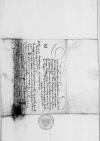Wir haben den XII dits E(wer) F(urstlichen) D(urchlauch)t mit yrem lauffenden bothen / und den andern tag dornach bei koniglichem kemmerer(r) cf. Ioannes DANTISCUS to Albrecht I von Hohenzollern-Ansbach Schmolainen (Smolajny), 1540-03-12, CIDTC IDL 5475;
Ioannes DANTISCUS to Albrecht I von Hohenzollern-Ansbach Schmolainen (Smolajny), 1540-03-11, CIDTC IDL 5474⌊geschriebencf. Ioannes DANTISCUS to Albrecht I von Hohenzollern-Ansbach Schmolainen (Smolajny), 1540-03-12, CIDTC IDL 5475;
Ioannes DANTISCUS to Albrecht I von Hohenzollern-Ansbach Schmolainen (Smolajny), 1540-03-11, CIDTC IDL 5474⌋. / So ist heuten unser diener, der E(wer) F(urstlichen) D(urchlauch)t schreiben in bewusten sachen an hoff mit sich genommen, / widder an uns gelangt, / mit sich diese beÿgelegte brieffe an E(wer) F(urstliche) D(urchlauch)t gebracht, / aus welchem vorstehenn wirt, / wie gantz angeneme Sigismund I Jagiellon (Zygmunt I) (*1467 – †1548), King of Poland and Grand Duke of Lithuania (1506-1548); Duke of Głogów (Glogau) (1499-1506), Duke of Opava (1501-1506), Governor of Silesia (1504-1506); son of King Kazimierz IV Jagiellon and Elisabeth of Austria⌊ko(nigliche)r m(aieste)tSigismund I Jagiellon (Zygmunt I) (*1467 – †1548), King of Poland and Grand Duke of Lithuania (1506-1548); Duke of Głogów (Glogau) (1499-1506), Duke of Opava (1501-1506), Governor of Silesia (1504-1506); son of King Kazimierz IV Jagiellon and Elisabeth of Austria⌋, unnserm aller gnedigisten herren, E(wer) F(urstliche) D(urchlauch)t trewhertzig anzeigen durch unsern hoffbruder, den herren Nikolaus Nibschitz (Mikołaj Nipszyc) (*ca. 1483 – †1541), royal courtier, diplomat in the service of Sigismund I and Albrecht von Hohenzollern-Ansbach, Dantiscus' friend; from 1525 until his death an official representative of Duke Albrecht at the Cracow royal court; from 1532 royal secretary; 1519 royal envoy to Albrecht von Hohenzollern, Grand Master of the Teutonic Order, 1525, 1526 envoy to Hungary, 1527 envoy to the Congress in Wrocław, 1531-1533, 1537 envoy to Ferdinand I of Habsburg, 1535-1537, 1540 envoy to Brandenburg, 1536 envoy to the estates of Livonia⌊NibschitzNikolaus Nibschitz (Mikołaj Nipszyc) (*ca. 1483 – †1541), royal courtier, diplomat in the service of Sigismund I and Albrecht von Hohenzollern-Ansbach, Dantiscus' friend; from 1525 until his death an official representative of Duke Albrecht at the Cracow royal court; from 1532 royal secretary; 1519 royal envoy to Albrecht von Hohenzollern, Grand Master of the Teutonic Order, 1525, 1526 envoy to Hungary, 1527 envoy to the Congress in Wrocław, 1531-1533, 1537 envoy to Ferdinand I of Habsburg, 1535-1537, 1540 envoy to Brandenburg, 1536 envoy to the estates of Livonia⌋ gethan, / gewest ist. / Die zwene herren, die E(wer) F(urstlichen) D(urchlauch)t geschrieben, / haben uns auch yre meinung zuerkennen geben, / beclagen mit uns solch unchristlich vornehmen etc. Und hat uns der hochwirdige probably Johann Koye ⌊von der Coÿeprobably Johann Koye ⌋ graff zu Gorcka durch sein eigen handtschreiben gebethen, / in E(wer) F(urstlichen) D(urchlauch)t uf das fleissigst zubefelhen. /
Neues ist nicht sonders an uns kommen, / das E(wer) F(urstliche) D(urchlauch)t nicht wuste. / Es wirt uns geschrieben, / das Citizens of Nuremberg ⌊die von NormbergCitizens of Nuremberg ⌋ beÿ inn Ferdinand I of Habsburg (*1503 – †1564), from 1521 Archduke of Austria, from 1526 King of Bohemia and Hungary, Croatia and Slavonia as Ferdinand I, 1531-1558 King of the Romans, 1558-1564 Holy Roman Emperor; son of Philip I the Handsome and Joanna the Mad of Castile, a younger brother of Charles V of Habsburg⌊ro(mische)r ko(nigliche)r m(aieste)tFerdinand I of Habsburg (*1503 – †1564), from 1521 Archduke of Austria, from 1526 King of Bohemia and Hungary, Croatia and Slavonia as Ferdinand I, 1531-1558 King of the Romans, 1558-1564 Holy Roman Emperor; son of Philip I the Handsome and Joanna the Mad of Castile, a younger brother of Charles V of Habsburg⌋ gros ehre haben bewiesen / und dreissig tausent gulden geschenckt etc. und das ir m(aieste)t mit dem Francis I of Valois (*1494 – †1547), 1515-1547 King of France; son of Charles, Count of Angoulême, and Louise of Savoy⌊konige von FranckreichFrancis I of Valois (*1494 – †1547), 1515-1547 King of France; son of Charles, Count of Angoulême, and Louise of Savoy⌋ im The Low Countries (Netherlands), region around the delta of the Rhine, Schelde (Scheldt), and Meuse rivers, includes modern Belgium, the Netherlands, Luxembourg and parts of northern France and western Germany⌊NidderlandThe Low Countries (Netherlands), region around the delta of the Rhine, Schelde (Scheldt), and Meuse rivers, includes modern Belgium, the Netherlands, Luxembourg and parts of northern France and western Germany⌋ bei Charles V of Habsburg (*1500 – †1558), ruler of the Burgundian territories (1506-1555), King of Spain as Charles I (1516-1556), King of Naples and Sicily, King of the Romans (1519-1530), Holy Roman Emperor of the German Nation (elected 1519, crowned 1530, abdicated 1556); son of Philip I the Handsome and Joanna the Mad of Castile⌊key(serliche)r m(aieste)tCharles V of Habsburg (*1500 – †1558), ruler of the Burgundian territories (1506-1555), King of Spain as Charles I (1516-1556), King of Naples and Sicily, King of the Romans (1519-1530), Holy Roman Emperor of the German Nation (elected 1519, crowned 1530, abdicated 1556); son of Philip I the Handsome and Joanna the Mad of Castile⌋ sollen sein, / dohin Sigismund I Jagiellon (Zygmunt I) (*1467 – †1548), King of Poland and Grand Duke of Lithuania (1506-1548); Duke of Głogów (Glogau) (1499-1506), Duke of Opava (1501-1506), Governor of Silesia (1504-1506); son of King Kazimierz IV Jagiellon and Elisabeth of Austria⌊ko(niglich)e m(aieste)tSigismund I Jagiellon (Zygmunt I) (*1467 – †1548), King of Poland and Grand Duke of Lithuania (1506-1548); Duke of Głogów (Glogau) (1499-1506), Duke of Opava (1501-1506), Governor of Silesia (1504-1506); son of King Kazimierz IV Jagiellon and Elisabeth of Austria⌋, unser allergnedigister herr, iren botschafter mit nahmen N. Otzieski, / der etwan bei dem crokischen herren vorstorben, / gedÿnet, / hat abgefertigt, / das zu unser ruhe, dorin wir Gott loben, / nicht unnutz etc. Sonst E(wer) F(urstliche) D(urchlauch)t wissen wir dismals nichts sonders zuschreiben, / der gunst wir uns vortraulich und wilferig bevelhen. /
 GStA PK, HBA, C1 No 651 2 unnumbered
GStA PK, HBA, C1 No 651 2 unnumbered  GStA PK, HBA, C1 No 651, 1 unnumbered
GStA PK, HBA, C1 No 651, 1 unnumbered 
